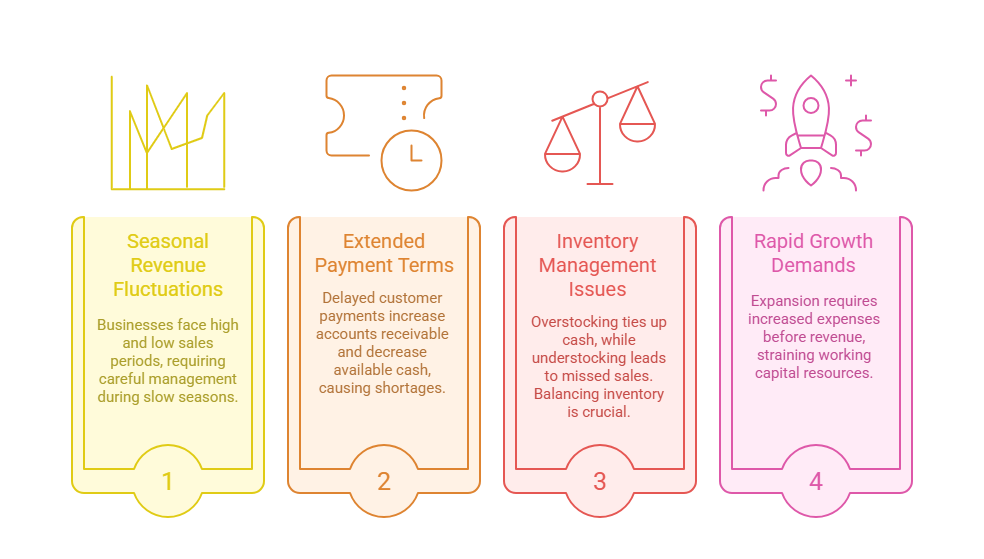For small business owners, understanding the term working capital is fundamental to maintaining healthy operations and ensuring long-term success. Working capital represents the financial cushion that keeps your business running smoothly on a day-to-day basis. It's the difference between what you can quickly convert to cash and what you owe in the near term.
Many entrepreneurs focus heavily on sales and profits, but they might overlook this critical financial metric. Without adequate working capital, even profitable businesses can face serious cash flow challenges that threaten their ability to pay suppliers, cover payroll, or handle unexpected expenses.
This comprehensive guide will walk you through everything you need to know about working capital, from basic calculations to advanced management strategies that can strengthen your business's financial foundation.
What Working Capital Means for Your Business

- Define the Basic Concept: Working capital represents your business's operational liquidity, calculated as current assets minus current liabilities. This figure shows how much readily available funds you have to cover short-term obligations and keep operations running smoothly.
- Identify Current Assets: These typically include cash, accounts receivable, inventory, and other assets you can convert to cash within one year. The key is focusing on items that can quickly become available for operational expenses.
- Recognize Current Liabilities: Short-term debts like accounts payable, accrued expenses, and any debt payments due within 12 months fall into this category. Understanding these obligations helps you plan for upcoming financial commitments.
- Calculate Your Position: Simply subtract your current liabilities from your current assets to determine your working capital position. A positive number indicates you have sufficient resources to meet short-term obligations, while a negative result may signal potential liquidity challenges.
How to Calculate Working Capital Effectively
- Gather Your Financial Statements: Start with your most recent balance sheet to identify all current assets and current liabilities. Ensure your data is up-to-date and accurate, as outdated information can lead to poor financial decisions.
- List All Current Assets: Include cash on hand, checking and savings account balances, accounts receivable, inventory at market value, and any short-term investments. Don't forget prepaid expenses that provide future value to your business.
- Total Your Current Liabilities: Add up accounts payable, short-term debt payments, accrued wages, taxes owed, and any other obligations due within the next 12 months. This gives you a complete picture of your immediate financial responsibilities.
- Apply the Working Capital Formula: Subtract total current liabilities from total current assets. The resulting figure represents your working capital position and indicates your ability to handle operational expenses without external financing.
Why Working Capital Matters for Business Operations
- Maintain Daily Operations: Adequate working capital ensures you can pay suppliers, cover payroll, and handle routine expenses without disruption. This stability allows you to focus on growing your business rather than constantly worrying about cash flow.
- Handle Unexpected Expenses: Equipment repairs, emergency inventory purchases, or sudden market changes require immediate financial resources. Strong working capital provides the flexibility to address these challenges without compromising operations.
- Take Advantage of Opportunities: Whether it's a bulk purchase discount, a new market opportunity, or seasonal demand increases, having sufficient working capital allows you to act quickly when profitable situations arise.
- Build Credibility with Suppliers: Consistent payment abilities strengthen relationships with vendors and may lead to better terms, early payment discounts, or priority service during high-demand periods.
Common Working Capital Challenges Small Businesses Face

- Seasonal Revenue Fluctuations: Many businesses experience periods of high and low sales throughout the year. During slow seasons, maintaining adequate working capital becomes crucial for covering fixed expenses while revenue drops.
- Extended Payment Terms: When customers take longer to pay invoices, your accounts receivable increase while available cash decreases. This timing mismatch can create working capital shortages even when sales are strong.
- Inventory Management Issues: Overstocking ties up cash in unsold products, while understocking can lead to missed sales opportunities. Finding the right balance is essential for optimal working capital management.
- Rapid Growth Demands: Expanding operations often requires increased inventory, more staff, and higher operating expenses before additional revenue materializes. This growth phase typically strains working capital resources.
Strategies to Improve Your Working Capital Position
- Accelerate Accounts Receivable: Offer early payment discounts, implement efficient invoicing systems, and follow up promptly on overdue accounts. Consider requiring deposits for large orders or shortening payment terms for new customers.
- Optimize Inventory Levels: Use data analytics to predict demand more accurately and avoid overstocking slow-moving items. Negotiate better terms with suppliers to reduce upfront inventory investments while maintaining adequate stock levels.
- Manage Accounts Payable Strategically: Take advantage of payment terms without damaging supplier relationships. Pay early only when significant discounts are offered, and communicate openly with vendors during temporary cash flow challenges.
- Consider Alternative Funding Options: When traditional working capital isn't sufficient, explore revenue-based financing or merchant cash advances that provide quick access to funds based on your business's performance rather than lengthy approval processes.
Understanding the term working capital is more than just knowing a financial formula, it's about grasping a fundamental concept that can make or break your business's operational success. By regularly monitoring your working capital position, you gain valuable insights into your company's financial health and can make informed decisions about growth, spending, and financing.
Remember that working capital management is an ongoing process, not a one-time calculation. Market conditions, seasonal changes, and business growth all affect your working capital needs. Stay proactive by reviewing your position monthly and adjusting your strategies as needed.
Strong working capital management provides the foundation for business stability and growth. It gives you the confidence to pursue new opportunities, weather unexpected challenges, and build lasting relationships with suppliers and customers. Whether you're just starting out or looking to expand, maintaining adequate working capital should remain a top priority in your financial planning efforts.

.png)






